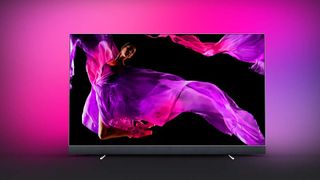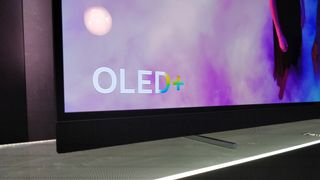TechRadar Verdict
Philips’ latest picture processing has somehow eked out more HDR intensity from the 65OLED+903 than we’ve seen from any other OLED TV to date. Its 4K pictures are so crisp and detailed they almost look like 8K too, while all the picture glories are partnered by an outstanding sound system. All wrapped up within a gorgeous, Ambilight-supported design.
Pros
- +
Phenomenally sharp pictures
- +
Exceptional HDR playback
- +
Gorgeous Ambilight design
- +
Outstanding sound quality
Cons
- -
Some occasional colour issues
- -
Audio boost costs £500
- -
Complicated to use
- -
No Dolby Vision support
Why you can trust TechRadar
When Philips announced its OLED 803 television back in February, it marked a notable turn away from the company's high-end LCD range to the promise of OLED’s superior displays. It was surprising, sure, but the 803 wouldn't be the only OLED from the European arm of Philips - we'd also be treated to the spectacular OLED+ 903, reviewed here.
While OLED still ain't cheap, and there's a price tag attached (£2,499 for the 55-inch model, and £3,499 for the 65-inch version), you get what you pay for with this Ambilight-imbued stunner: Not only is its screen great but, thanks to Bowers & Wilkins, it provides the perfect, well-rounded home audio, too.
Has Philips' latest OLED stood out in a crowded market? We think so.
[Update: As Philips waits to roll out its new 2019 Philips TVs, the OLED+ 903 has got a tempting price drop: the 65-inch model is now £3,000 down from £3,500, while the 55-inch is only £2,000 down from £2,500. Not exactly bargain prices, but enough to make the 903 a contender for this year as well.]

Design
No other OLED TV looks like the Philips 65OLED+903. From its ultra-slim metallic screen frame and striking, felt-covered built-in soundbar to its tiny gleaming feet, it’s a beautifully distinctive - and extremely well built - television. It also boasts that extreme, almost impossible rear panel thinness over its top third that’s become such a classic OLED trademark.
Turn it on and the uniqueness of its design goes to a whole new level, since that’s when Philips’ Ambilight technology kicks in, sending pools of light erupting from the screen’s left, right and top edges. This isn’t just any old light, either; you can choose its colour and intensity, or you can set it to track the colour content of the picture you’re watching. This picture tracking sees the lights tracking the tone and position of different objects within the picture.
You do, it has to be said, need to tread quite a fine line with Ambilight’s settings. Leave the brightness too high or the aggressiveness of its response too strong and it can become distracting. With both of these elements set to relatively calm levels, though, Ambilight can actually make you feel more engrossed in what you’re watching - as well as making long-term viewing in dark rooms less tiring.
The soundbar mentioned in passing earlier really has been brilliantly integrated into the 65OLED+903’s design. Its depth doesn’t protrude beyond the extra depth already added by the TV’s tuner and panel driver electronics; it sits flush with the front of the screen; its felt cover looks high quality and harmonises perfectly with the the rest of the TV’s colour scheme; and it tucks very neatly and compactly (given how powerful it is) between the bottom edge of the screen and those strikingly narrow metallic feet.
The Philips 65OLED+903 boasts what initially looks like a great set of connections, including four HDMIs, three USBs, and the usual Bluetooth and Wi-Fi network connections. There is, though, a catch with the HDMIs, as it turns out that only two of them support 4K and HDR feeds at up to 60 frames a second. The other two only manage 4K HDR at 30fps.
This seems a little penny pinching on a £3,499 TV, but I guess it won’t impact many households ... unless they forget to figure out which HDMIs are full bandwidth and which aren’t.
One last design element worth mentioning is the 65OLED+903’s ‘smart’ remote control. This is essentially a slim metallic ‘wand’ with just a handful of buttons on it that works surprisingly well for day to day viewing.
Design TL;DR: The 65OLED+903 is beautifully built and gorgeous to look at - especially when Ambilight is strutting its stuff. It manages to incorporate a seriously powerful sound system, too, without seriously compromising its style.

Smart TV (Android TV)
The Philips 65OLED+903 smart features are predominantly provided by the Nougat version of Android TV. This is not, it must be said, our favourite smart TV engine. Its full-screen interface and layout feel rather old fashioned and clumsy by today’s standards, it doesn’t seem very attuned to your own personal likes and dislikes, and it’s not easy to customise.
Philips’ version of Android TV does run fairly slickly and stably, though, compared with the implementation of the Nougat platform in Sony’s ‘X1 Extreme’ processing TVs.
Key apps covered by the 65OLED+903 include Netflix, Amazon Prime Video, YouTube, and Rakuten. Netflix works in 4K and HDR, but Amazon only mustered 4K during my tests, and YouTube didn’t do 4K or HDR. Though Philips assures me that it should have supported 4K, at least. Android TV does not, unfortunately, cover the catch up TV apps for all the UK’s main terrestrial broadcasters.
Smart features TL;DR: Android TV is still a rather intimidating and inflexible beast that also lags behind rivals in terms of local catch up TV support and HDR support on Amazon and YouTube. At least it runs fairly stably on the 65OLED+903, though.

HD/SDR Performance
The 65OLED+903 is a pretty remarkable performer with HD and standard dynamic range content - chiefly because it does such an excellent job of turning them into 4K and HDR! That's good because the upscaling performance delivered by Philips’ latest P5 picture processing engine is pretty stellar on two fronts: First, it adds a huge amount of sharpness and detail to sub-4K pictures - detail which includes more colour refinement and enhances the image’s sense of depth and scale. Second, it delivers this detail while seldom exaggerating source noise.
On the contrary, since the P5 engine now sits on a single chip (rather than being spread across separate chips as happened with previous Philips processing systems) and so can deliver its picture enhancements in the most effective order, source noise is generally recognised and removed hugely effectively. Though there is a caveat to this we’ll get to in a minute.
The P5 engine also does a strikingly aggressive job of turning standard dynamic range sources into HDR, thanks to a new ‘Perfect Natural Reality’ processing element. Peak brightness levels are hugely expanded without becoming ‘bleached’ at the same time that black levels are made even deeper, while colours have their saturations enriched across the board without any tones starting to look over-dominant or ‘shouty’.
This SDR to HDR performance is an important achievement, as unless you’re a die-hard image purist, you may well find going back to watching SDR content at ‘native’ SDR brightness and colour levels feeling pretty painful once you’ve experienced HDR.
That said, if you are a purist the 65OLED+903 can also do a beautiful native SDR job. Its OLED-driven black levels remain gorgeous, and its management of light in each OLED pixel is such that its rendering of subtleties of light, shade and colour provide a potent, beautiful reminder of just why SDR managed to stick around pretty much unchallenged for so many decades.
There are a couple of caveats where the 65OLED+903’s management of HD/SDR is concerned. First, while noise is generally well handled by the upscaling circuitry, very grainy HD sources can look a little distractingly fizzy after they’ve gone through Philips’ aggressive detail enhancement engine. The sort of content that causes this tends to be pretty rare, though.
The other issue is that while the balance and subtlety of the 65OLED+903’s colours once it’s put SDR content through its HDR converter is admirable, they don’t tend to look quite as outright punchy as they do with the SDR-toHDR converters of most rival TVs.
HD/SDR TL;DR: Regardless of whether you’re watching SDR in its native form or upgraded to HDR, the 65OLED+903 makes it look not just lovely, but spectacular. And it’s hard to think of any other TV that makes HD look more like 4K.

4K/HDR Performance
Good though the 65OLED+903 is with HD and SDR sources, its pictures feel like they’ve been designed first and foremost with 4K and HDR playback in mind. In fact, it sets new standards for OLED screens in two key areas.
First, it somehow makes the bright peaks of HDR sources - sunlight reflecting of metal and skin, dazzling sunsets, blazing headlights, streetlamps and so on - look more intense than they have on any other OLED TV we’ve tested. It’s hard to understand how Philips has managed this, but the difference is clear while running the 65OLED+903 side by side with a couple of rival OLED models. And it has a really startling effect on how impactful HDR pictures look.
Philips’ latest processing also typically delivers exceptionally punchy, wide-ranging colours with HDR sources, while simultaneously reproducing levels of colour finesse that leave LG’s OLED TVs looking slightly rough-and-ready by comparison.
HDR black levels are gorgeously deep, as usual with OLED TVs, but also full of subtle greyscale detailing, and largely immune to the sort of subtle noise and sudden shifts to grey that some (admittedly mostly older) OLED TVs can suffer with. Since this is an OLED TV, moreover, even when a really bright HDR object appears against a really dark HDR backdrop there’s no hint of light ‘leakage’ around the bright object like you’d expect to see on an LCD TV.
The 65OLED+903’s OLED panel means there’s also no reduction or shift in colour saturation and contrast if you watch it from an angle.
Put all of its strengths together, and overall we’d say the 65OLED+903 delivers the most truly HDR experience of any OLED TV to date. It’s worth adding, too, that while some of the best LCD TVs can deliver significantly more brightness and colour volume with HDR sources, no LCD TV so far can match the beautiful intensity and lustre the 65OLED+903 can deliver during predominantly dark scenes.
The 65OLED+903’s P5 processing also takes helps it bring out every possible drop of detail - and then some - from native 4K sources. In fact, it somehow manages to make native 4K look more detailed and sharp than any other 4K TV I’ve tested so far - be it OLED or LCD. This is despite, of course, it only having exactly the same 3840x2160 pixel count as all those other 4K TVs.
Philips’ excellent motion processing means that most of this clarity remains intact even when there’s movement in the frame.

The 65OLED+903’s extreme sharpness hardly ever looks forced or ‘processed’ (which it sometimes has on previous generations of Philips TV). Just occasionally your eye can be drawn to a bit more ‘liveliness’ in large areas of a relatively consistent colour than you would see on a typically softer-looking rival. But I think most people will see this as a fairly small price to pay for the extreme way the 65OLED+903 exposes 4K’s advantages.
Particularly grainy 4K sources can sometimes, as noted with SDR playback, have their inherent noise marginally exaggerated by the 65OLED+903’s picture engine. Though if this does happen with a particular title, Philips does provide some reasonably clever noise reduction tools amid its picture options.
One other issue with the 65OLED+903’s 4K HDR pictures is that just occasionally a colour tone - typically a fairly bland one, such as a shade of brown sand or a skin tone - can look slightly unnatural, and out of kilter with the usually impressive tonal management on show elsewhere.
It’s worth stressing, too, that to get the very best out of the 65OLED+903, it’s worth learning your way around its rather complicated picture set up menus. Its noise reduction and motion compensation settings are particularly important to its overall success, and you should also turn off all of its Eco settings, and make sure the Contrast Mode is set to Best For Picture.
Very unusually, we’d argue that the out of the box picture preset that delivers the all-round most exciting picture is the Vivid one. Such modes are typically best avoided with other TV brands, but here it seems to be the setting that gets the most value out of Philips’ excellent P5 video processing engine. It is also, crucially, far less prone to showing up the colour tone issue we mentioned earlier than the other presets.
The Vivid mode’s main catches are that it can bring out a bit too much compression noise in digital sources, and slightly crush detail in dark areas. As a result, we sometimes wished there was an HDR picture preset which delivered a good compromise between the Vivid and rather flat and lifeless looking Movie mode.
One last key picture performance achievement of the 65OLED+903 is its input lag; the time it takes to render picture data. Happily, despite the powerful processing engine at its heart, if you select the TV’s Game picture preset it can get input lag down to only 22ms. This is a good result for a TV.
4K/HDR Performance TL;DR: The 65OLED+903 also delivers the most aggressively sharp 4K pictures and punchiest HDR pictures I’ve seen on an OLED TV. There are one or two ill side effects from this aggressive approach, but for the most part the 65OLED+903’s 4K HDR pictures look jaw-dropping.

Sound
The 65OLED+903’s built in soundbar is almost stupidly good considering how compact and unassuming it looks. Designed in collaboration with British hi-fi speaker designer Bowers & Wilkins, it yields exceptional amounts of distortion-free power, bolstered by a beautiful directness (thanks to the way the drivers fire forward into the room) and a strikingly expansive but controlled mid-range. This provides the perfect, well-rounded home for everything from deep or shrill vocals to aggressive action movie effects and soaring movie scores.
Bass sounds excellent too. Deep enough to be convincing during explosions, rolling tank rumbles and dinosaur footfalls, but never overwhelming or ‘monotone’. It always feels a natural part of the wider sound mix too, rather than just ‘hanging off the bottom’ of the mid range.
There’s an almost hi-fi sensibility to the way the 65OLED+903 projects subtle details in movie mixes, too.
Finally, the B&W connection can clearly be heard in the startling refinement, purity, polish and balance of its performance with music.
Sound TL;DR: The 65OLED+903’s audio is so good it makes adding a separate soundbar unnecessary for all but the most demanding AV households.

Other panels to ponder...
The closest rival for the 65OLED+903 is the Panasonic 65FZ802. The Pana delivers a slightly more refined picture that’s arguably more focused on capturing the director’s intention. But the Philips set delivers a more aggressive ‘wow’ effect with its remarkable sharpness and aggressive HDR highlights.
If you already have a separate audio solution, you may well be better opting for Philips’ own 803 OLED series - it uses a less powerful integrated sound system, but essentially delivers the same picture quality as the OLED+903 for £500 less.
If you want the sort of brightness with HDR that LCD can offer, the current pick of the LCD crop is Samsung’s direct-lit QE65Q9FN.
Final verdict
The 65OLED+903 is a pretty remarkable achievement. It delivers the punchiest HDR pictures of any OLED TV we’ve tested so far, without compromising OLED’s natural advantages of gorgeous black levels and ultra-wide viewing angles. It also converts SDR to HDR exceptionally well if you want to do that.
As if that wasn’t impressive enough, the brilliant pictures are accompanied by one of the best sound systems ever built into a ‘mainstream’ TV.
- Don't miss our round-up of the best TVs in 2018
AV Technology Contributor
John has been writing about home entertainment technology for more than two decades - an especially impressive feat considering he still claims to only be 35 years old (yeah, right). In that time he’s reviewed hundreds if not thousands of TVs, projectors and speakers, and spent frankly far too long sitting by himself in a dark room.


